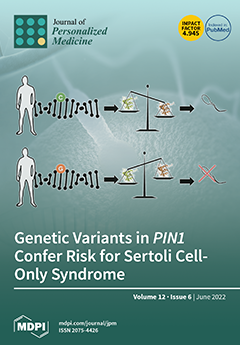(1) Background: To date, the response of patients with rheumatoid arthritis (RA) to the various biologic DMARD available cannot be predicted due to a lack of reliable biomarkers. Based on our preliminary work on tmTNF reverse signaling, we developed a whole-blood assay measuring
[...] Read more.
(1) Background: To date, the response of patients with rheumatoid arthritis (RA) to the various biologic DMARD available cannot be predicted due to a lack of reliable biomarkers. Based on our preliminary work on tmTNF reverse signaling, we developed a whole-blood assay measuring tmTNF crosslinking-induced IL-10 production to predict the response to TNF inhibitor (TNFi) therapy. (2) Methods: This prospective study included patients with active RA. Depending on the clinical judgment of the attending rheumatologist, either therapy with a TNF or JAK inhibitor was initiated. Clinical parameters and blood samples were obtained at baseline and after 8 weeks of therapy. The blood samples were collected using a newly developed whole-blood assay based on the principle of tmTNF reverse signalling. Subsequently, IL-10 was measured via enzyme-linked immunosorbent assay (ELISA) technique. (3) Results: 63 patients with RA were enrolled. In fifteen patients, TNFi therapy was initiated, while eight patients started a JAKi treatment. The cross-sectional analysis of all patients showed a positive correlation between tmTNF crosslinking-induced IL-10 and parameters of disease activity (CRP [r = 0.4091,
p = 0.0009], DAS28 [r = 0.3303,
p = 0.0082]) at baseline. In the TNFi treatment study, IL-10 was found to be significantly higher in EULAR responders than in non-responders (
p = 0.0033). After initiation of JAKi treatment, in contrast, IL-10 induction was not linked to response. Longitudinal analysis of the TNFi-treated patients revealed IL-10 to decrease in responders (
p = 0.04), but not in non-responders after 8 weeks of therapy. Of importance, the IL-10 production at baseline correlated inversely with TNFi response determined by ΔDAS28 in patients with TNFi treatment (r = −0.5299,
p = 0.0422) while no such link was observed under JAKi therapy (
p = 0.22). Receiver operation characteristics (ROC) analysis demonstrated a high performance of tmTNF/crosslinking-induced IL-10 in predicting a TNFi therapy response according to the EULAR criteria (AUC = 0.9286, 95% Confidence interval 0.7825–1.000,
p = 0.0055). (4) Conclusions: In this pilot investigation, we demonstrated the feasibility of a whole-blood assay measuring tmTNF-induced IL-10 to predict clinical response to TNF inhibitor treatment. This approach might support rheumatologists in their decision for an individually tailored RA therapy.
Full article






